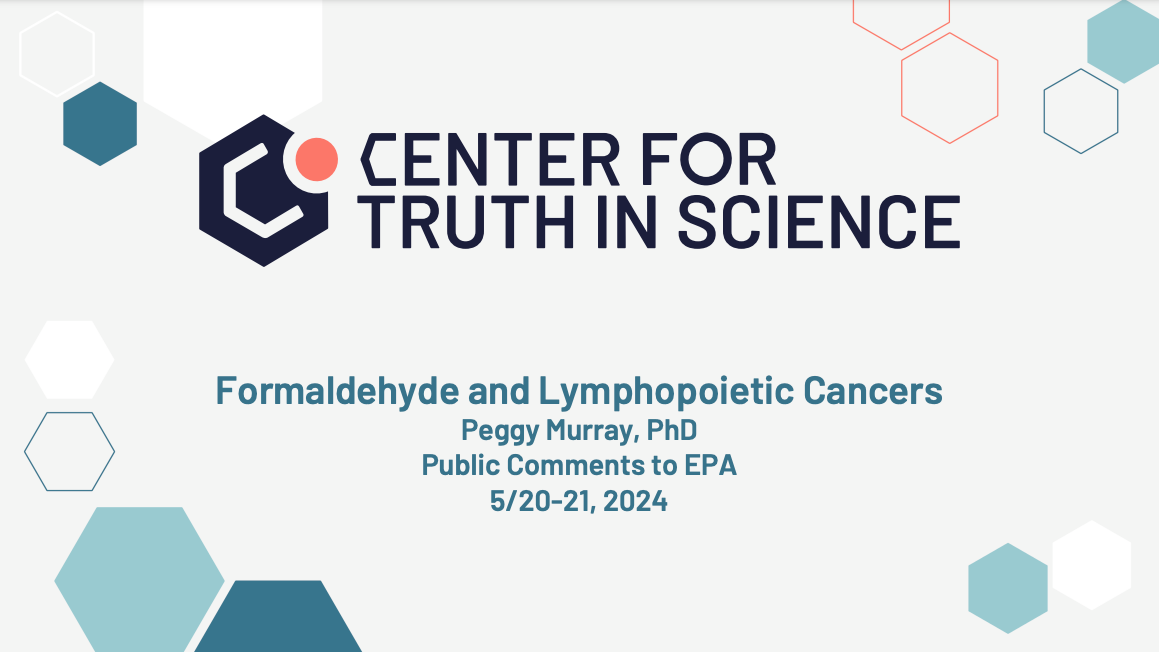As you can see from the Center’s most recent work on formaldehyde (read more here), there is nothing settled regarding the EPA’s current risk evaluation of the chemical, which is required by the Toxic Substances Control Act (TSCA). The review of the chemical has been years in the making, and most recent activity led by the EPA was a public meeting held on May 20-23 by the Scientific Advisory Committee on Chemicals (SACC), read more here.
During this session, the EPA-selected SACC members had the opportunity to hear oral public comments from more than 40 scientists, trade association representatives, affected companies, former EPA officials, and other groups. In addition, more than 200 written comments were submitted to EPA. It is important to note that none of the oral comments supported EPA’s draft Risk Assessment claim that formaldehyde poses an unreasonable risk to human health.
The Center was well represented at the meeting, with comments given by Dr. Peggy Murray, Research Director, as well as lead author of a new Center-funded systematic review of formaldehyde’s relationship to myeloid leukemia and other cancers of the blood: Melissa Vincent (Tox Strategies).
The concern from many scientists, industry, and consumer groups is that EPA has gone too far in determining the risk levels for formaldehyde, especially for workers, and did not base their conclusions on good science, in fact leaving out the results of available studies.
Criticism regarding the EPA’s methods and interpretation of results adds to the growing need for more and extended peer review. The SACC has said they will go beyond the charge the EPA has given them. According to reporting by Inside EPA, some SACC Members, “… intend to go beyond their formal charge and address the agency’s decision to base it in part on a controversial draft Integrated Risk Information System (IRIS) assessment — with at least two of the experts already appearing critical of the choice.”
During SACC’s May 20-24 peer review meeting members of the panel questioned EPA staff multiple times on the office of Pollution Prevention and Toxics’ (OPPT) decision to use the draft IRIS assessment, as well as the status of the assessment (i.e., has it been finalized?). Some members also raised questions about the TSCA risk assessment document itself. An EPA toxics official said this could delay the evaluation’s current Dec. 31 target.
Why is all this important? As we have said before (see here), formaldehyde is made naturally in the human body and is a by-product of forest fires, cooking, and automobile exhaust. It is also widely used in industries such as composite wood products (plywood, pasteboard), embalming fluid, vaccines, medicine, adhesives, paper towels, makeup, insulation, cars, computers, furniture, cabinets, and textiles. According to E&E News, formaldehyde is added to animal feed to kill bacteria that might infect livestock. Pork producers use it to prevent viral diseases, and it helps reduce the risk of salmonella contamination in food. It’s also added to fertilizer to boost crop growth over time.
Any changes in environmental policy that result from the TSCA risk evaluation will affect the economy, especially jobs. It is important to keep workers and consumers safe. And both of these considerations make the use of the best science unquestionable. While it is a no-brainer to most observers, it appears the EPA needs to be reminded of this.
See below for more details on CTS’s participation in the SACC public meeting.
